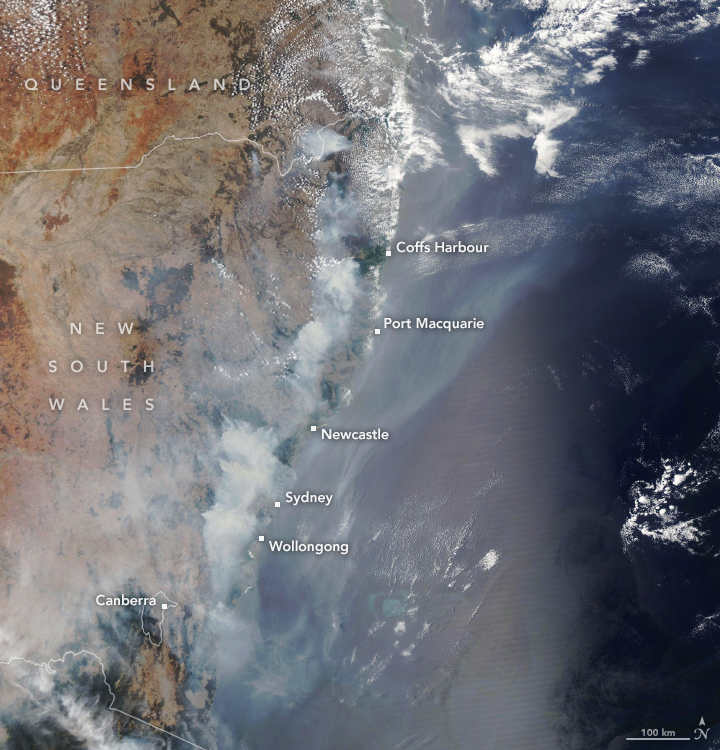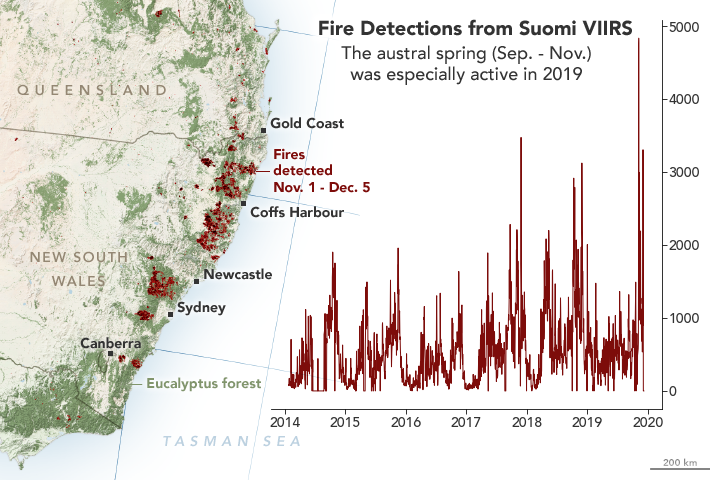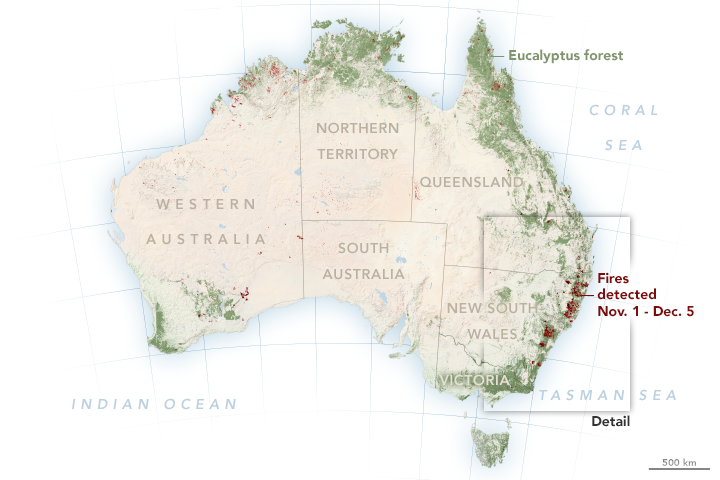
Fires Take a Toll on Australian Forests
Downloads
- australiafires_amo_2019343_lrg.jpg (2600x2708, JPEG)
- australia_vir_2019339.png (720x480, PNG)
- australia_vir_2019339_wide.png (720x480, PNG)
Metadata
- Sensor(s):
- Suomi NPP - VIIRS
- Data Date: December 9, 2019
- Visualization Date: December 12, 2019

The fire season in New South Wales normally ramps up in December. In 2019, unusually hot weather and a potent drought primed the region for a roaring start in October. Two months later, more than 100 fires are still raging in forests and bush areas near the southeast coast, including some subtropical rainforests and eucalyptus forests that do not often see fire.
By December 12, 2019, fires in New South Wales had charred 27,000 square kilometers (10,000 square miles), an area about the size of Maryland. Vast plumes of smoke and pollution have streamed from fires for weeks, enveloping coastal towns and cities with toxic haze and smoke. Parts of Sydney, a city of 5 million people, recently endured pollution levels several times above what is considered hazardous, according to news reports.
The fires have been particularly damaging to eucalypt forests and woodlands, which thrive in areas of relatively dry and nutrient-poor soil. These forests are prone to big outbreaks of fire because many of the trees species have oil-rich foliage that is extremely flammable. The map above, based on data from Australia’s Department of Agriculture, shows the range of eucalypt forests. Red dots show the locations of fires as detected by the Visible Infrared Imaging Radiometer Suite (VIIRS) on the Suomi NPP satellite between November 1 and December 5, 2019. The natural-color image was acquired by the Moderate Resolution Imaging Spectroradiometer (MODIS) on NASA’s Aqua satellite on December 9, 2019.

Fires actually help many eucalyptus species release their seeds and germinate. “During a fire, their woody capsules empty their contents onto a nutrient-rich ash seedbed from which all the understory competition for light, water, and nutrients has been removed,” explained Ayesha Tulloch, a University of Sydney conservation biologist. “At the wrong time — such as in this case — fires can be devastating for eucalypt forests.” A lack of rain before or after a blaze can sharply limit seed germination.
The effects of fires in eucalyptus forests ripple through the animal kingdom. “Browsing animals like kangaroos are driven out by fire for a short time, and the heat-treatment of soil reduces the number of plant-eating insects and soil organisms during the early growth period,” said Tulloch. Many koalas, which are slow moving, have been affected or even killed by fires in 2019. “But the range of the koala covers most the east coast of Australia,” she said. “Relative to its range, the fires are relevant to only a very small proportion of the existing koala population in Australia.”
Though normally immune to fire because of moist conditions, the drought and hot temperatures of recent years have made rainforests and wet eucalyptus forests vulnerable. “Rainforest systems from Australia’s northern wet tropics, to Lamington National Park, to alpine montane ecosystems have experienced massive fires,” said Tulloch. “These systems cannot tolerate fire, and most plants are killed by it,” adding that they will not recover nearly as quickly as dry eucalyptus forests can.
References
- Department of Agriculture (2018) Australia’s State of the Forests Report 2018. Accessed December 12, 2019.
- The Guardian (2019, November 26) Koala factcheck: have the Australian bushfires put survival of the species at stake? Accessed December 12, 2019.
- NASA Earth Observatory (2019) Wildfires in Australia. Accessed December 12, 2019.
- News.com (2019, December 12) NSW Rural Fire Service map shows massive extent of bushfires. Accessed December 12, 2019. ??
- New South Wales Rural Fire Service Major Fire Updates. Accessed December 12, 2019.
- The Washington Post (2019, December 12) Raging bush fires torch 5.3 million acres in New South Wales, Australia, turning beaches black with ash. Accessed December 12, 2019.
- The Sydney Morning Herald (2019, December 11) Air quality ten times hazardous levels in Sydney. Accessed December 12, 2019.
NASA Earth Observatory images by Joshua Stevens and Lauren Dauphin, using VIIRS data from NASA EOSDIS/LANCE and GIBS/Worldview, and the Suomi National Polar-orbiting Partnership, MODIS data from NASA EOSDIS/LANCE and GIBS/Worldview and Landsat data from the U.S. Geological Survey. Eucalyptus forestry data is from Australia's State of the Forests Report 2018. VIIRS fire location data from the Fire Information for Resource Management System (FIRMS). VIIRS trend data from the University of Maryland. Story by Adam Voiland.
This image record originally appeared on the Earth Observatory. Click here to view the full, original record.